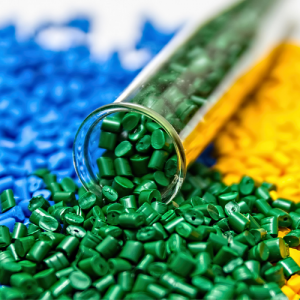
You have probably heard of plastic injection molding, but what exactly is it?
According to Solid Works:
Plastic injection molding is the most common method of manufacturing plastic parts because it typically creates the final part design in a single step, without the need for any secondary operations such as trimming or finishing.
In the plastic injection molding process, a machine injects a molten polymer under high pressure into a mold that contains the cavity corresponding to the part design. The polymer flows from the injection molding machine to the cavity through a feed system. After the cavity fills, the machine continues to pack melted plastic material that solidifies after it cools down. Finally, the machine ejects the solid part.
The cycle time required for the production of a single part is typically seconds, or at most, minutes. A short cycle time lets you reach a high volume of production.
The following schematic shows a typical injection molding machine.
| Components of Injection Molding Machine | Function | |
|---|---|---|
| 1 | Injection Unit | Receives the plastic pellets in a hopper (2) and transfers them into a heated barrel containing a rotating and reciprocating screw (3), and a nozzle (4). |
| 2 | Hopper | Contains and dispenses the plastic pellets for the injection molding process. |
| 3 | Screw | Transports the pellets through the barrel, heating them to create a homogenous melt, a process termed plastication. |
| 4 | Nozzle | Once the injection unit (1) produces an adequate amount of melted plastic, the reciprocating action of the screw (3) injects the melted plastic through the nozzle into the mold unit (5). |
| 5 | Mold Unit | Holds the cavity (6) inside the molding plates together with the feed system of runners (7), cooling channels (8), ejector pins, and the moving and stationary plates (external boundaries). |
| 6 | Cavity | The part cavity is filled with molten polymer that cools, and after injection forms the manufactured part. |
| 7 | Feed System | Provides the flow path for the melted polymer into the cavity. The feed system comprises runners, sprues, and gates. |
| 8 | Cooling Channels | Cooling channels remove heat from the mold. Individual cooling channels are usually connected in series with one inlet and one outlet. You can use water or other coolants such as ethylene glycol in the cooling circuit. |
| 9 | Clamping Unit | Uses a motor drive and tie bars to open and close the mold, and prevent the mold from opening during the injection process. |
| 10 | Control Unit | Monitors and controls the processing parameters like temperature, pressure, screw position, and speed. |
| 11 | Hydraulic Unit | Adjusts and maintains the proper hydraulic pressure to control the mechanical pressure. |